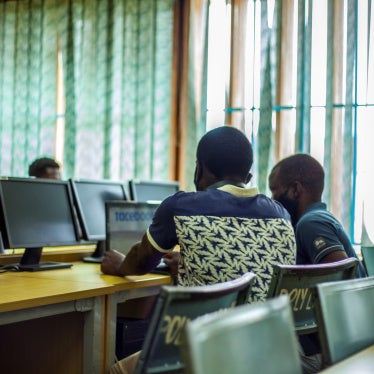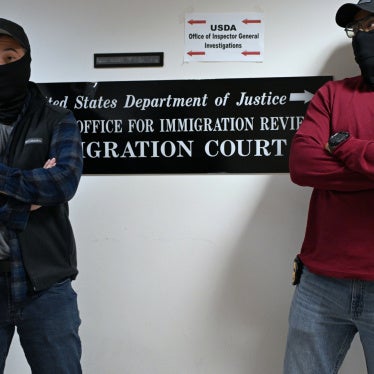Introduction
Human Rights Watch has documented the use of child labor in small-scale gold mining in Mali, Ghana, and Tanzania. Children are subject to the worst forms of child labor—in particular, hazardous child labor—when they work underground, carry heavy loads, work with dangerous tools, and use toxic mercury. Children have been involved in serious mining accidents, poisoned by mercury through regular exposure during processing, and been victims of sexual abuse and economic exploitation in the context of small-scale gold mining. Children who work in mining often drop out of school or do not attend in the first place. The gold from small-scale mines often reaches the global gold market—unbeknownst to consumers—through a long supply chain that starts with child labor.[1]
Addressing child labor in mining is a complex process. Child labor interventions can only succeed if there is a strong political will on the part of the government to address the issue. In some countries, social protection schemes in support of the poorest households, and efforts to improve access to education, have been important strategies to address child labor. Other successful strategies have included strict enforcement of child labor laws and pressure from international businesses seeking to eliminate child labor from their supply chain. Strategies to end child labor in mining always require the involvement of local communities concerned, local authorities, a range of government ministries (such as those dealing with labor, child protection, and mining), businesses, nongovernmental organizations, and technical experts.
To the conveners of the ICGLR-OECD-UNGoE Forum
· Devote increased attention to eliminating the worst forms of child labor;
· Conduct a pilot program on child labor due diligence;
· Develop detailed guidance on child labor in the minerals supply chain;
· Reach out to include the ILO as a stakeholder in meetings of the Forum.
To governments
· Address the root causes of child labor by supporting orphans and other vulnerable children through social protection schemes for vulnerable populations, such as conditional cash transfers or other measures;
· Ensure that primary education is truly free of charge, and ensure access to primary and secondary education, as well as vocational training, in mining areas;
· Monitor and regularly inspect licensed and unlicensed mines for child labor, withdraw children working in mines, and impose penalties against those who employ child labor. Government measures should respect human rights and not lead to retribution;
· Explicitly address child labor in efforts to formalize and professionalize the small-scale mining sector;
· Take measures to eliminate the most harmful practices of mercury use in small-scale gold mining, in line with the Minamata Convention on Mercury.
To gold trading companies, gold refining companies, and gold retailers
· Ensure that existing due diligence policies and guidelines are thorough, in line with the OECD Guidance, and include an explicit child labor component. Child labor due diligence should include:
- Regular monitoring of child labor issues in countries where gold is being sourced from, including through contacts with ILO, NGOs, and monitoring of child labor-related publications; and through visits to artisanal mines;
- Policies adequate to ensure that the company will be able to detect the alleged use of child labor by any of its suppliers, and effectively investigate those allegations. This should include direct, proactive monitoring as well as transparent and effective grievance and whistleblower mechanisms;
- Clear and effective procedures the company will take to address any adverse human rights impacts of its operations, including use of child labor by its suppliers.
· Specifically investigate all credible reports that child labor is being used.
· In the event that child labor is found to have occurred in a company’s supply chain, take action to address the situation:
- Immediately inform government authorities and urge them in writing to take measures to end the use of child labor in small-scale gold mining within a specified timeframe, for example, to seek measurable improvements within one year through labor inspections and improved access to education;
- Immediately inform suppliers and urge them to take measures to end the use of child labor in their supply chain within a specified timeframe, such as two years, in order to facilitate children’s transition out of work;
- Support credible and effective measures to end the social causes of child labor, for example, through projects that improve access to education and withdraw children from child labor;
- Immediately ending a trading relationship or implementing a larger boycott of gold from certain areas should not be the answer, as this would negatively affect the income of mining communities and might even increase child labor. Rather, companies should establish benchmarks with a timeframe for specific progress on the elimination of child labor for its suppliers and the mines concerned.
To large-scale gold mining companies located near small-scale gold mining communities
· Develop programs to address child labor in small-scale mining, in consultation with local government, nongovernmental organizations, and regional miners’ associations, as part of community engagement strategies.
[1] Human Rights Watch, Toxic Toil: Child Labor and Mercury Exposure in Tanzania’s Small-Scale Gold Mines, August 2013, https://www.hrw.org/sites/default/files/reports/tanzania0813_ForUpload_0.pdf; “Ghana: Mine Accident Highlights Risks to Children,” Human Rights Watch news release, June 13, 2013, https://www.hrw.org/news/2013/06/13/ghana-mine-accident-highlights-risk-children; Human Rights Watch, Mercury: A Health and Human Rights Issue, May 2012, https://www.hrw.org/sites/default/files/related_material/2112-mercury-health-treaty.pdf; Human Rights Watch, A Poisonous Mix: Child Labor, Mercury, and Artisanal Gold Mining in Mali, December 2011, https://www.hrw.org/sites/default/files/reports/mali1211_forinsertWebUpload_0_0.pdf.








